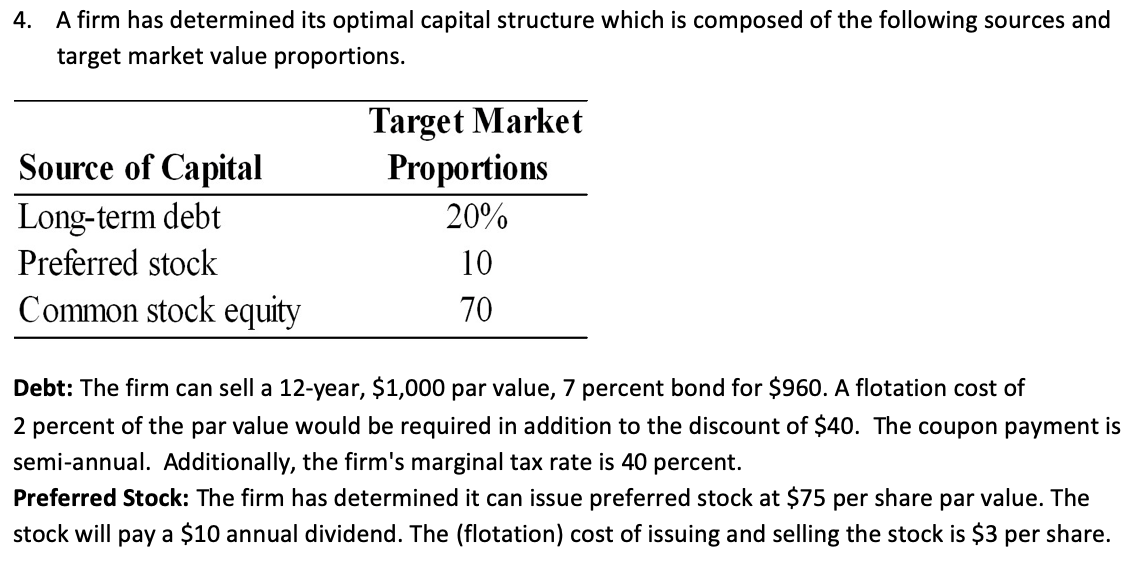
In today's complex financial landscape, understanding the relationship between sources of funding and target market value proportions is crucial for any firm. Companies must navigate the intricate balance of debt and equity financing to optimize their capital structure. This article delves into the implications of debt on a firm's operational strategies and market positioning, providing insights that can empower stakeholders to make informed decisions.
The dynamics surrounding debt and its impact on a firm's value are multifaceted. By analyzing how different sources of capital influence market perception and financial performance, businesses can tailor their strategies to align with market expectations. This exploration is particularly relevant in the context of the current economic climate, where access to capital can dictate competitive advantage.
This article will cover various aspects of how firms can leverage debt while maintaining a healthy balance within their target market. We will explore theoretical frameworks, case studies, and practical applications, ensuring that readers walk away with a comprehensive understanding of this critical business function.
Table of Contents
Understanding Sources of Debt
Debt financing can come from various sources, each with distinct advantages and disadvantages. Understanding these sources is essential for firms looking to optimize their capital structure.
Types of Debt Financing
- Bonds: Long-term debt securities issued to investors.
- Bank Loans: Traditional loans from financial institutions.
- Lines of Credit: Flexible borrowing options from banks.
- Trade Credit: Short-term credit extended by suppliers.
Benefits of Debt Financing
Utilizing debt can enhance a firm's financial leverage, allowing for greater investment opportunities. Some benefits include:
- Tax Deductibility: Interest payments on debt can be tax-deductible.
- Increased Capital: Access to additional funds for growth initiatives.
- Ownership Retention: Unlike equity financing, debt does not dilute ownership.
Target Market Value Proportions Explained
Target market value proportions refer to the distribution of a firm's market value across different stakeholder groups. Understanding these proportions is vital for strategic decision-making.
Components of Market Value
- Equity Value: Represents ownership interest in a firm.
- Debt Value: The total value of a firm's debt obligations.
Market Perception and Value Proportions
The perception of a firm’s value can significantly impact its market capitalization. Factors influencing market perception include:
- Financial Health: Strong balance sheets attract investors.
- Market Trends: Sector performance can sway investor opinions.
The Role of Debt in Firm Strategy
Incorporating debt into a firm's strategy can influence various operational aspects, including growth potential and risk management.
Debt as a Growth Catalyst
Firms can leverage debt to fund expansion projects, increasing their market share and revenue. However, this must be balanced with the associated risks of increased financial obligations.
Risk Management Considerations
Managing debt levels is crucial to avoid potential pitfalls such as bankruptcy or insolvency. Effective risk management strategies include:
- Regular Financial Audits: Assessing financial health periodically.
- Debt Covenants: Setting restrictions on further borrowing.
Case Studies: Successful Debt Management
Several firms have successfully navigated the complexities of debt financing, leading to significant growth and market leadership.
Case Study 1: Company A
Company A utilized bonds to finance its expansion into international markets, resulting in a 20% increase in revenues over three years.
Case Study 2: Company B
Company B effectively managed its bank loans by diversifying its funding sources, leading to improved stability during economic downturns.
Impact of Debt on Firm Valuation
The relationship between debt and firm valuation is complex. While debt can enhance returns, excessive leverage can lead to decreased valuation due to heightened risk perception.
Valuation Models
Various models exist to evaluate the impact of debt on a firm's value, including:
- Discounted Cash Flow (DCF) Analysis
- Comparable Company Analysis
Market Reactions to Debt Levels
Investors often react to changes in a firm's debt levels, which can influence stock prices and overall market confidence. Monitoring these reactions is crucial for maintaining investor relations.
Debt Management Strategies
Effective debt management is essential for long-term sustainability. Strategies include:
Diversification of Funding Sources
Relying on a single source of debt can be risky. Firms should diversify their funding sources to mitigate this risk.
Regular Review of Debt Obligations
Conducting regular reviews of debt agreements helps firms stay informed about their financial commitments and opportunities for refinancing.
Common Pitfalls in Debt Financing
While debt can be a powerful tool, firms must be cautious of common pitfalls that can jeopardize their financial stability.
Over-leveraging
Taking on too much debt can lead to cash flow issues and increased bankruptcy risk. Firms should maintain a balanced approach to leverage.
Lack of Financial Planning
Insufficient planning regarding debt repayment can result in missed payments and damage to credit ratings. Robust financial planning is essential.
Conclusion and Future Considerations
In summary, understanding the relationship between sources of debt and target market value proportions is vital for firms aiming to optimize their capital structure. By leveraging debt strategically while managing associated risks, companies can enhance their market position and drive growth.
As the financial landscape continues to evolve, it is crucial for firms to stay informed about best practices in debt management. We encourage readers to engage with this topic further by sharing their thoughts in the comments or exploring related articles.
Call to Action
If you found this article insightful, please consider sharing it with your network or leaving a comment below. Your feedback is invaluable as we strive to provide quality content that meets your needs.
Positive Closure
Thank you for taking the time to read this article. We hope to see you back here for more engaging discussions on financial strategies and best practices in the future!
ncG1vNJzZmivp6x7rLHLpbCmp5%2Bnsm%2BvzqZmm6efqMFuxc6uqWarlaR8p7vLpaawoZ6cerS71KuanqtdlruledOaqaCdpGK6or7KnqtmrpGhwqZ5z6umqaeiqbawutJmm56apGLBqbGMn6CrpV2Yrq96x62kpQ%3D%3D
